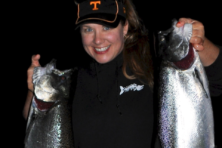Wild Things: Advocates of Clean Air, Water
- Share
- Tweet
- Pin
- Share

If you have a passion for clean water, sustainable agricultural practices and habitat restoration, Jodi Labs would love to hear from you.
A Green Bay lawyer, Labs is the current national president of the Izaak Walton League of America (IWLA), an environmental organization that promotes natural resources protection and outdoor recreation.
“I’d love to see chapters formed in Door and Kewaunee County,” Labs said. “After all, there are plenty of conservation issues each county is dealing with that could benefit from a strong group of advocates working together for a common goal.”
Labs said it takes at least 10 interested individuals to secure a charter from the national organization, and she and state president of the Wisconsin Division of IWLA, Mike Fuge, are willing to assist anyone who wants to see it happen.
“I’d jump in with both feet,” said Fuge, of Stevens Point. “It’s a grassroots, bottom-up organization: local chapters, state division, and then the national office.”
There are currently eight chapters in the state, down from more than two dozen in the mid-1900s. But Fuge believes grassroots organizations will be on the rebound as more people learn what’s really happening to the face of the land and in our waters.
The League was formed in 1922 when 54 hunters and anglers met in Chicago to establish an organization dedicated to taking action to combat water pollution and threats to wildlife and habitat. It was named in honor of Sir Izaak Walton, an avid fisherman who wrote the book, The Compleat Angler.

The Wisconsin Division started in 1923, and the Brown County chapter was formed in 1925. Among many accomplishments since, Labs said chapter members played an integral part in getting the government to hold the paper companies responsible for the Fox River clean-up.
“Our goal is to ensure that natural resources are protected, managed, and used in a sustainable manner for generations to come,” Labs said.
Aldo Leopold was deeply involved in the League. He was a frequent contributor to the group’s publication, Outdoor America, and served as director of the League’s Wisconsin Division.
Fuge said the Wisconsin Division assists, compliments and supports the local chapters. The Division also administers a grant program for conservation projects among schools, youth groups and service organizations.
“It’s got to be a project where the feet are going to get wet, or the hands are going to get dirty,” said Fuge.
Learn more by emailing Fuge at [email protected] or by calling him at
League of Its Own
The first advocacy victory came 100 years ago, when Congress established the Upper Mississippi River National Wildlife and Fish Refuge. It protects one of the most diverse and complex wetland ecosystems in America. Much of it likely would have been drained and converted to farmland if not for the League’s efforts.
Members in the 1920s and ‘30s helped release largemouth and smallmouth bass fry across the country, conducted the first national survey of water pollution and led a national push to build sewage treatment plants in every community.
There’s a lot more accomplishments. Here are some of them:
•In 1932, the League adopted a resolution to create an annual migratory bird stamp as a means of raising funds for waterfowl sanctuaries. In 1934, Congress passed the Migratory Bird Hunting Stamp Act, a law based on that resolution. Member Jay “Ding” Darling designed the first of what would become known as the Duck Stamp.
•Helped develop and pass a law preventing damming of the Boundary Waters and flooding in the Superior National Forest, and acquired land and donated it to the Forest Service to preserve what would ultimately become the Boundary Waters Canoe Area Wilderness.
•Fought for clean water through legislation in the 1930s and 1940s, but wasn’t satisfied and kept pushing right through the Clean Water Act in 1972.
•League advocacy helped lead to the passage of the Pittman-Robertson Act in 1937, which directed excise tax revenues from the sale of guns, ammos and archery equipment to state wildlife agencies to fund wildlife restoration, habitat conservation, and hunter education.
•The group testified to the U.S. Department of Agriculture about the dangers of DDT in 1964, then sued the agency over its failure to respond. In 1972, the newly-created Environmental Protection Agency banned the use of DDT in America.
•The success of the Pittman-Robertson Act led to the passage of the Dingell-Johnson Act in 1950. It uses funds raised by taxes on fishing gear to support protection of fish habitat.
•New programs to include more youth in natural resources issues, encourage hunter safety, and increase access to and protection of public lands were launched; and educated farmers on sustainable agricultural practices, encouraged federally-protected wilderness areas, and inspired the Land and Water Conservation Fund.
•League leaders were active in promoting the Wild and Scenic Rivers Act, the Save Our Streams campaign, and recycling awareness. The group also won provisions for protecting soil health in the 1985 Farm Bill, known as Sodbuster, Swampbuster, and the Conservation Reserve Program. These provide more than 20 million acres of wildlife habitat, protect tens of millions of acres of wetlands on farms, and conserve soil on 100 million acres of highly erodible farmland.
•More recently, the League pushed for responsible ATV use, paid for ads to teach anglers and boaters about aquatic invasive species, and developed curricula to teach kids about clean water and the importance of getting outdoors. Members also monitor and raise awareness about chloride (salt) pollution, and assist with the Clean Water Hub, a user-friendly database that displays water quality data from volunteer monitors.



